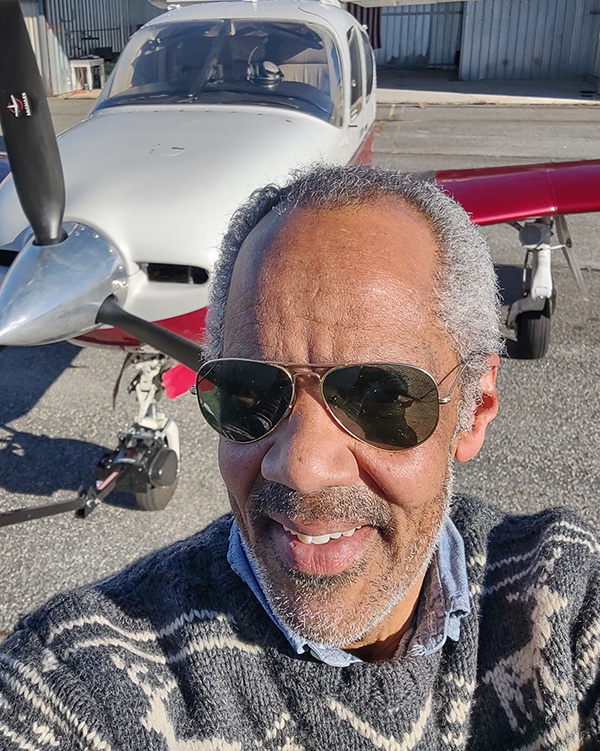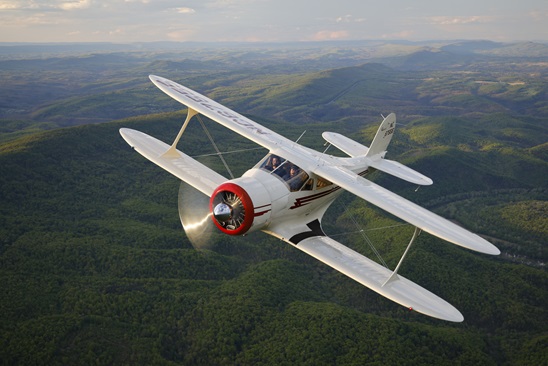Destination: District of Columbia
National Celebration of GA Flyover on track for May 11
"We woke up to beautiful skies, airplanes that are ready, pilots that are ready … I couldn't be happier right now," said Mike Ginter, working the air boss position on May 11 as the first aircraft approached over the Potomac River in Washington, D.C.
Ginter, AOPA's Vice President of Airports and State Advocacy on weekdays, checked in to the live webcast by radio on May 11 as "Golden One," a Beechcraft Model 17 Staggerwing flown by AOPA President Mark Baker, approached the left turn toward the National Mall in Washington, D.C.
"Super cool," Baker reported on the radio as he flew the lead aircraft through prohibited airspace. "Once in a lifetime."
Ginter had a prime view of the unfolding show from the tower at Ronald Reagan Washington National Airport, closed for the hour to make way for the National Celebration of GA Flyover.
Beginning with the Staggerwing arriving right on time at 12:04 p.m., a procession of nearly 60 aircraft followed the route at 1,000 feet over Independence Avenue, in full view of spectators on the National Mall.
Ginter and the participating pilots had plenty of help getting this GA parade approved: The U.S. Congress and officials of 11 agencies including the FAA, the Transportation Security Administration, and the Secret Service worked with AOPA to coordinate the flight, which approached the city along the Potomac River before turning to follow the National Mall, using the Washington Monument as a course marker.
The flight
With broken clouds and light wind, aviation enthusiasts and the general public gathered around the Washington Monument on a mild spring day to watch the airborne exhibition. The Staggerwing Baker flew began a story, representing the epitome of Golden Age aviation, with advanced design features such as an enclosed cockpit and retractable landing gear. A Howard DGA, a WACO UPF–7, and a Fairchild 24 followed the Staggerwing to complete the Golden Age “chapter” of the flight.
Following GA chapters included the postwar period, with a North American Navion among the represented aircraft; the trainer era, with a Cessna 172; vertical flight; homebuilt aircraft; backcountry flying; business jets; and more.
Former AOPA editor in chief Thomas B. Haines and longtime aviation news correspondent Miles O’Brien, both highly knowledgeable and experienced aviators, provided commentary during the livestream of the flyover.
Air boss
Ginter and a team that included FAA personnel and AOPA staff put together a plan that timed the operation to the second. Participating pilots launched at departure times planned to create intervals that allowed deconfliction among the wide range of aircraft types and performance levels. With all of the aircraft sharing the same altitude, the flight had to be organized based on aircraft and pilot capabilities.
“During the briefing I tried to drive simplicity,” Ginter said in an interview prior to the event, noting that every pilot’s primary mission is to maintain the assigned altitude and airspeed and remain calm, knowing they are not in danger of being intercepted by the military or sanctioned by the FAA for airspace violations that normally would apply in the Flight Restricted Zone.
Cooperation from air traffic control (which began long before the day) also kept flyover on track. Ginter said John Hall, an air traffic control specialist with Potomac Consolidated Tracon, helped clear the way for the event and organized ATC participation.
“Thanks to John Hall, we are able to get into the belly of the beast. John and his colleagues at Potomac Tracon were incredible planning partners,” Ginter said.
Recording history
The celebration, which represents a lengthy vetting and approval process, is among the highlights of the 85 years since AOPA was founded to advocate for GA and the rights of pilots in 1939. Among its goals was to highlight the many benefits our nation derives from the GA industry and infrastructure.
While some might compare the planned parade of airplanes with a military operation because of the precision required, there are a few wedding-like elements such as photography and the intense pressure that goes with that job.
AOPA Video Production Manager Josh Cochran described the process of deciding how best to approach shooting for the livestream of the event that will be broadcast on YouTube. The goal is to capture the best possible footage of every aircraft taking part. To do so, the team had to get permission to set up cameras on several rooftops along the route, including FAA headquarters, the Smithsonian National Museum of American History, and a private building.
Then came the March 24 test flight of four aircraft led by AOPA President Mark Baker. The flight was designed to make sure the big event would flow smoothly, and while Ginter called the exercise “a piece of cake,” the video crews discovered unexpected gaps they needed to fill.
“The practice run showed us how much work we still had to do,” Cochran said. After adjusting camera positions, shooting sequences, and other details of their plan, the livestream team members are confident they can produce a memorable show that will keep the audience engaged.
"We're just thrilled with how it looked from here," Ginter said over the radio, just after 1 p.m., as the Titan Aerobatic Team's flight of three departed Washington, their smoke trails dissipating.
—AOPA Digital Media Managing Editor Jim Moore contributed to this report.
AOPA thanks the sponsors who helped make this possible:




